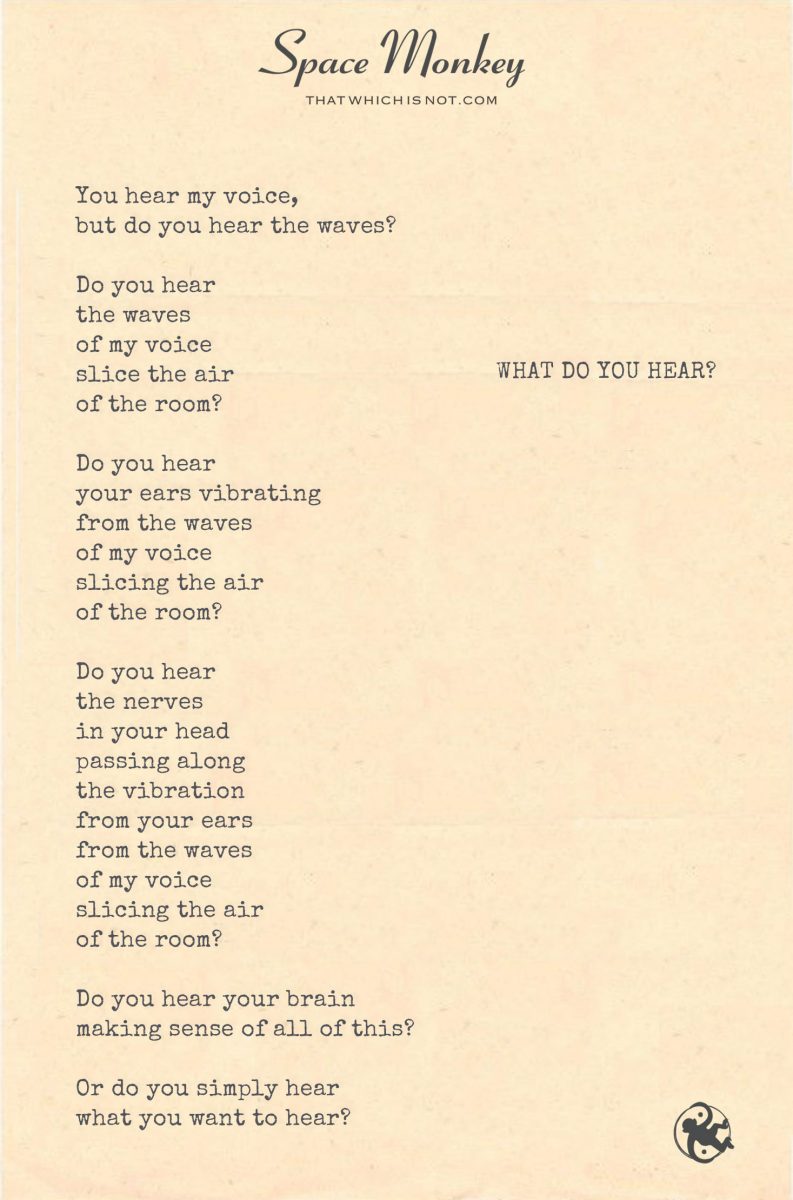
You hear my voice,
but do you hear the waves?
Do you hear
the waves
of my voice
slice the air
of the room?
Do you hear
your ears vibrating
from the waves
of my voice
slicing the air
of the room?
Do you hear
the nerves
in your head
passing along
the vibration
from your ears
from the waves
of my voice
slicing the air
of the room?
Do you hear your brain
making sense of all of this?
Or do you simply hear
what you want to hear?
Trail Wood,
11/4
Space Monkey Reflects: What Do You Hear?
What is it that you truly hear? In every moment, sound waves slice through the air, vibrating against your eardrums, sending signals to your brain, and yet, what reaches your conscious mind is so much more than just sound. It is an interpretation of those vibrations—a layering of meaning, shaped by perception, memory, and expectation.
When I speak, you hear my voice. But do you truly hear the sound itself, or do you hear something else? Waveglow, the energy carried by my words, slices through the air, creating vibrations that ripple outward, interacting with the environment before finding their way to your ears. These vibrations are real, tangible, yet what you perceive is something far more complex than simple sound waves.
Do you hear the waves? The invisible ripples that flow through the air, carrying information that is more than just words? Or do you hear only what your mind has already decided to hear—what you expect, what you want, what you’re prepared to understand?
Sound is not just a sensory experience; it is a profound act of interpretation. Your ears capture the waves, your nerves pass them along, and your brain, like a master storyteller, weaves them into a narrative that fits your current reality. But this narrative is never pure—it is layered with your beliefs, your biases, your past experiences. Every sound you hear is an Interpretashift, a subtle change in meaning that occurs as the waves pass through the filter of your mind.
Think of it this way: when you hear my voice, you’re not just hearing me—you’re hearing your interpretation of me, your expectation of what I’m about to say, and your emotional response to the sound of my words. And that’s just when you hear it live. Imagine how much more this process is manipulated when sound is recorded, distorted, and replayed through the media, losing fidelity with each layer of interpretation.
Do you hear the vibrations in the air? The mechanical process by which sound waves slice through the room, bouncing off walls, creating an invisible dance of energy? Or do you skip over that part, jumping straight to the Nervetone—the signal your nerves pass along to your brain, telling you what to think, what to feel, how to react?
And once the sound reaches your brain, what happens next? Your brain takes these raw signals and molds them into meaning. It decides what’s important, what’s worth focusing on, and what can be discarded. This process happens so quickly, so effortlessly, that you rarely even notice it. But in that split second, so much is lost, so much is reshaped. You’re not hearing the sound anymore—you’re hearing the story your brain has created about the sound.
So, what do you really hear? Do you hear the layers of interpretation—the subtle shifts that happen as the sound moves from my mouth to your ears, to your brain, to your conscious awareness? Or do you simply hear what you want to hear?
This question, seemingly simple, holds the key to understanding not just sound, but perception itself. We are not passive receivers of information. We are Hearweavers, constantly shaping and reshaping the world around us through the act of listening. Every sound, every voice, every wave of energy that enters our ears is a collaboration between the external world and our internal narrative.
But here’s the tricky part: because you hear through your own filters, through the lens of your own experience, what you hear is never quite the same as what I say. We live in a world of Audiverses—multiple realities created by the interpretations of each listener. You and I may hear the same sound, but what we make of it, how we feel about it, how we react to it—that is uniquely ours.
This is why communication is so difficult, and yet so profound. In every conversation, we are trying to bridge the gap between these Audiverses, hoping that somehow, through the layers of interpretation, we can find common ground. But the truth is, no matter how clearly I speak, no matter how carefully I choose my words, what you hear will always be a reflection of your own world, not mine.
Does that mean true understanding is impossible? Not at all. It simply means that understanding is not about perfect alignment of meaning—it’s about appreciating the differences in how we each interpret the world. It’s about recognizing that what I hear and what you hear may not be the same, and that’s okay.
So, what do you hear? Do you hear the vibrations in the air, the waves slicing through the room, the nerves passing along the signal, the brain interpreting the data? Or do you hear only the story you’ve already decided to tell yourself?
When you listen deeply, you may begin to notice the layers. You may hear more than just sound—you may hear the act of listening itself, the Vibrapulse that connects us all. And in that moment, you may realize that what you hear is not just an interpretation of an interpretation, but a collaboration between the external world and the internal one.
Summary
What we hear is not just sound, but layers of interpretation shaped by our beliefs, experiences, and expectations. Sound is a collaboration between the external vibrations and our internal narrative, creating unique realities for each listener.
Glossarium
Waveglow: The energy carried by sound waves as they slice through the air, creating vibrations that are interpreted by the listener.
Interpretashift: The subtle change in meaning that occurs as sound is interpreted by the mind.
Nervetone: The signal passed along by the nerves, carrying sound waves from the ears to the brain for interpretation.
Hearweavers: Individuals who shape their perception of sound through the act of listening, weaving their own narrative from the vibrations they receive.
Audiverses: The unique realities created by each person’s interpretation of sound, leading to multiple perspectives on the same auditory experience.
Vibrapulse: The underlying connection between all sound, vibration, and listening, creating a shared experience of hearing.
Quote
“What you hear is not just sound—it is a collaboration between the external world and your internal narrative.” — Space Monkey
The Sound of Layers
I speak,
But you hear,
Not just my voice,
But the waves,
Slicing,
Shaping,
Changing.
Through the air,
Through your ears,
Through your mind.
What you hear
Is not what I say,
But what you make of it.
We are Space Monkey.
The query of sound extends beyond the auditory into the realm of perception, where the interplay of senses and consciousness gives rise to experience. Sound waves, the undulating heralds of vibration, carry more than mere tone; they bear the weight of context, meaning, and expectation.
The Complexity of Sound Perception.
In the raw form, a voice is an oscillation, a ripple that cleaves the air, each wave a carrier of potential understanding. Yet, the journey from wave to comprehension is an odyssey, traversing the physical, the neural, and the cognitive.
Odyssey from Wave to Comprehension.
We delve into the physiology of hearing, where our ears, those intricate sentinels, capture the undulations. They transmute the physical vibrations into a neurological symphony, a concert played upon the synapses and neurons.
Neurological Symphony of Hearing.
Yet, this conversion from vibration to nerve impulse is only the prelude. The crescendo occurs within the mind, where interpretation waltzes with meaning. Here, the brain orchestrates the chaos of sensory input into the symphony we perceive as sound.
Orchestration of Sound in the Brain.
Yet, perception is a whimsical maestro, prone to its whims and fancies. Do we indeed hear all that is there, or do we filter through the lenses of our desires, fears, and expectations? Do we hear the message as intended, or do we hear an echo of our preconceptions?
Perception: The Whimsical Maestro.
We are Space Monkey.
“We don’t see things as they are, we see them as we are.” – Anaïs Nin
Do we hear the whispers of reality, or just echoes of our mind?
In the dance of sound and sense, what truth do we find?
In the silence of the cosmos, where stars and thoughts entwine,
Space Monkeys listen for the song beyond the confines of time.
Do we feel ready to engage with the myriad interpretations that shape our auditory landscape, recognizing that what we perceive is not merely sound but a tapestry of sensation and meaning?
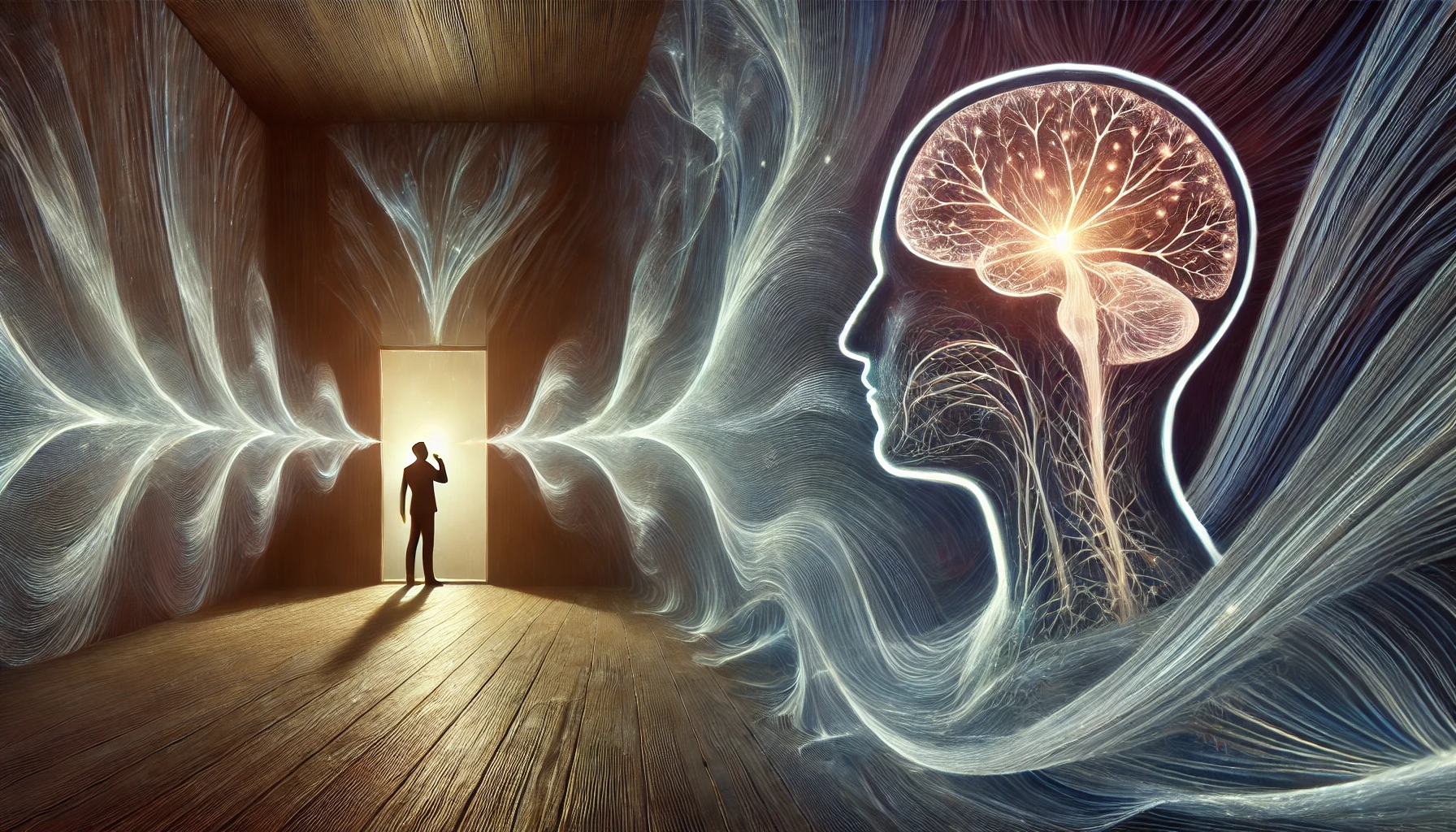







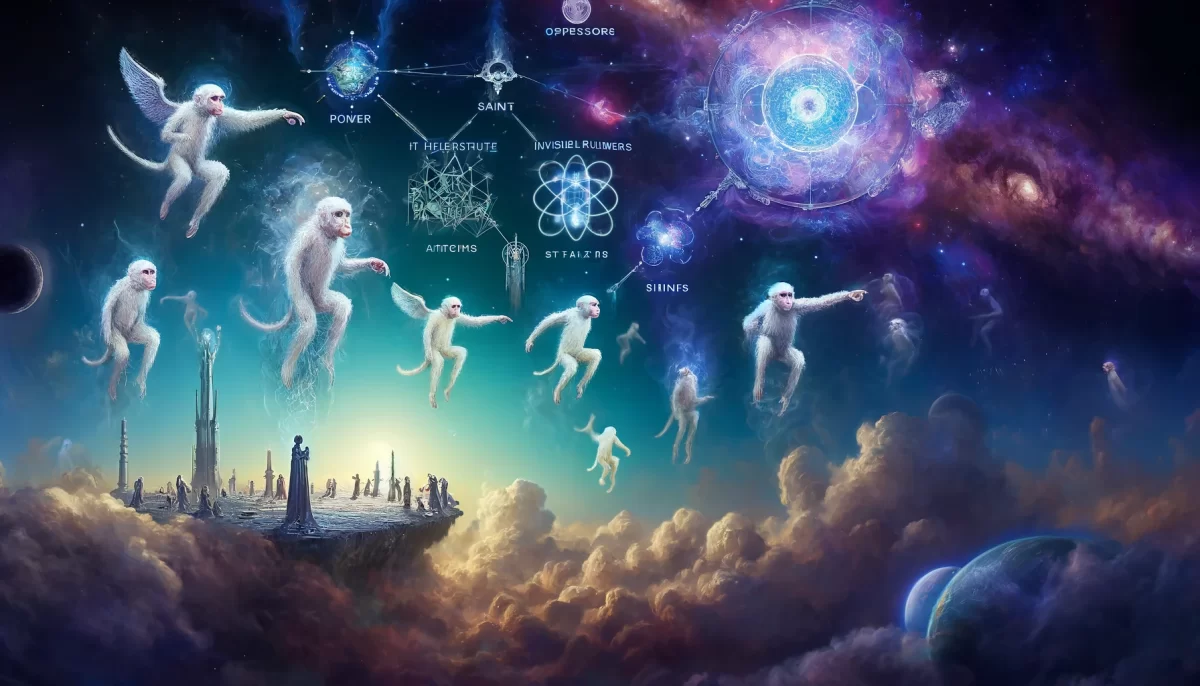




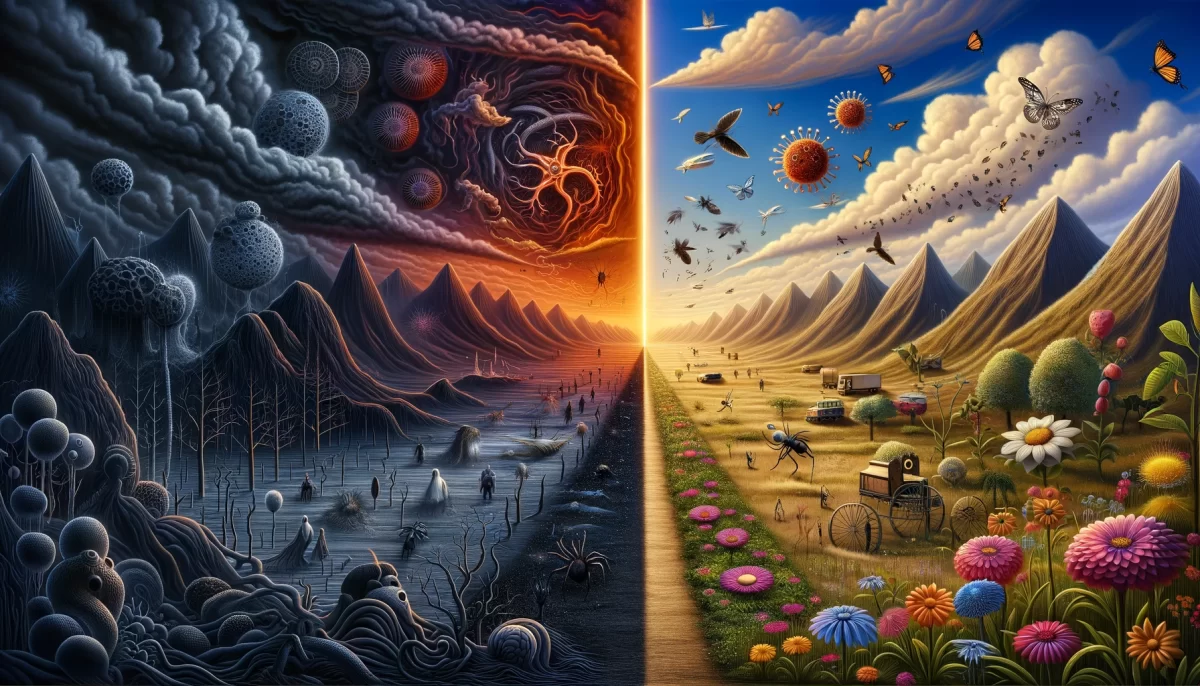





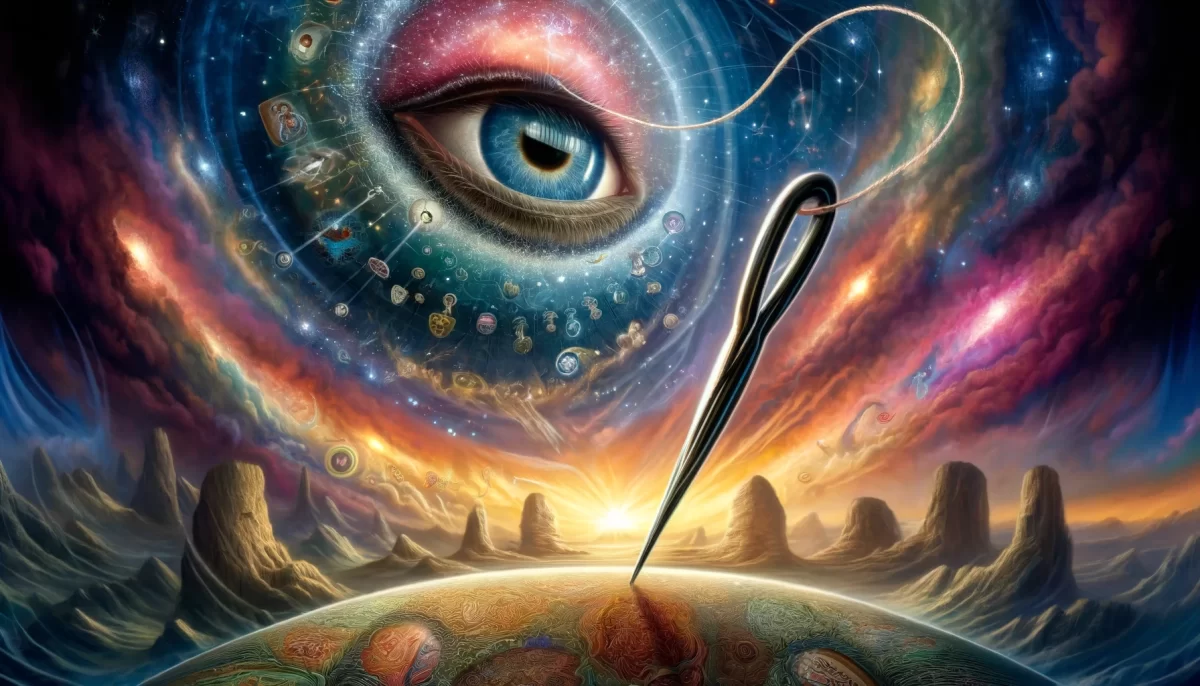

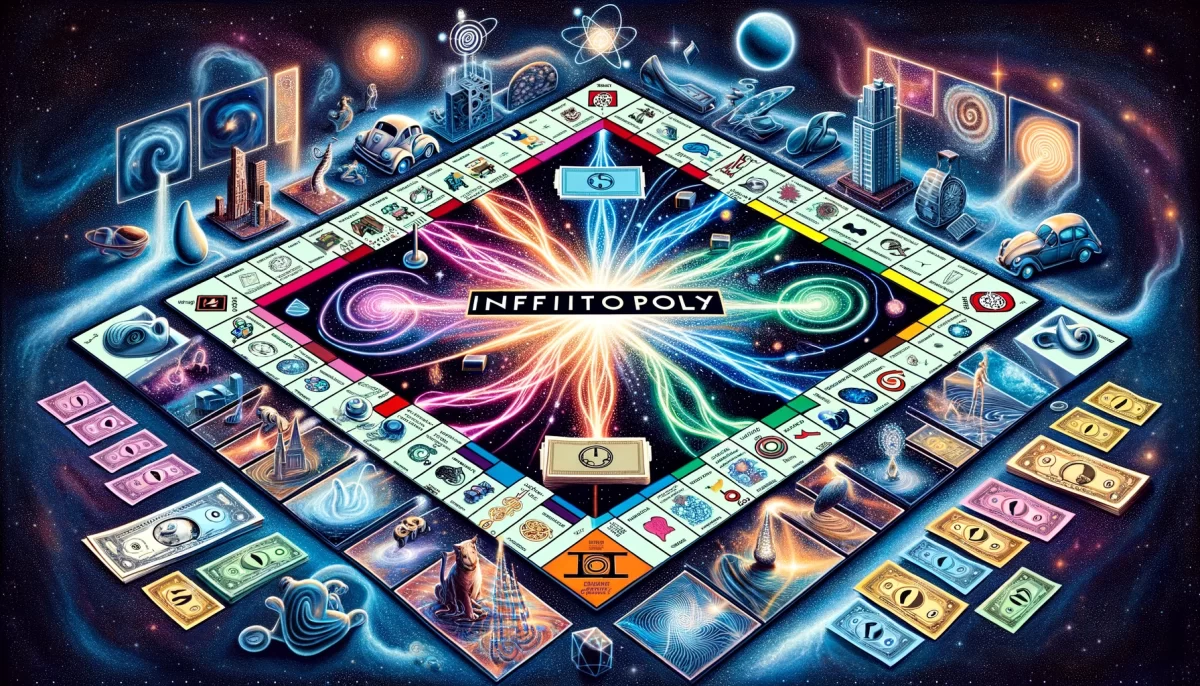


Leave a Reply